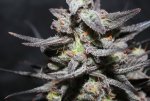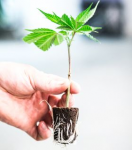Evergreen
Showmethelowers
Breeding cannabis is a complicated art that can be performed in plenty of ways. Here, we describe the common terms surrounding various cannabis genetics and how they came to be. We decided to keep it short and concise, as all the scientific minutiae can be very complex.
LANDRACE
Landrace varieties originate from regions where cannabis plants have been growing for a very long time in the wild—centuries, or even millennia. This naturally creates stable, robust genetics that produce a homogeneous offspring. This means that the landrace strains from a particular area will develop very similar growth patterns, appearance, and chemical composition. Hindu Kush or China Yunnan are examples of pure landrace strains.
F1
F1 stands for a "first generation hybrid". When two strains with completely different genotypes breed, for example, a Master Kush with Durban Poison, their offspring will be an F1 hybrid. When this hybrid is bred together with another F1 hybrid from the same batch (a sister or a brother), it creates an F2 hybrid. When this process is repeated, it creates an F3, then F4, and so on. After F5, the plants can be considered as IBL.
IBL
IBL stands for “inbred line”, meaning that after several generations of hybridising a specific lineage, the strains become almost like a different family of strains. Skunks were hybridized and selected for their very pungent and potent nature, and after many generations, they developed into the Cheese family, which can be called an IBL.
POLY-HYBRIDS
Poly-hybrids derive from mixing completely different hybrids with each other. For example, Master Kush and Durban Poison produce offspring called F1(A); AK-47 and White Widow produce an offspring called F1(B). When F1(A) and F1(B) have a lovechild, it will be coined as a poly-hybrid.
BACKCROSSES
Back-crossing refers to taking a hybrid strain and breeding it back with the original parent. For example, a male Chocolope and a female Jack Herer develop an F1 hybrid. When this F1 hybrid is hybridized with the original female Jack Herer, the resulting strain will be coined as BX1. When this BX1 gets back-crossed again with the original female Jack Herer, it will be coined as BX2, and so on. The genetics of the original female strain can be retained by keeping the plant in the vegetative stage as a mother, keeping the cuttings as clones or using tissue culture propagation.
SELFING
Selfing is when a mother plant is pollinated by herself. Breeders use special chemicals on female plants to induce stress, which results in the plants producing male flowers, which produce pollen. When this pollen in used on the female flowers of the same plant or a clone from the same mother, the resulting seeds will be “selfed” or coined as S1. When the S1 seeds are back-crossed with the original parent, they’re called S2, S3, and so on. Breeders often do this to preserve the genetics of the strain, and to feminize the seeds.
LANDRACE
Landrace varieties originate from regions where cannabis plants have been growing for a very long time in the wild—centuries, or even millennia. This naturally creates stable, robust genetics that produce a homogeneous offspring. This means that the landrace strains from a particular area will develop very similar growth patterns, appearance, and chemical composition. Hindu Kush or China Yunnan are examples of pure landrace strains.
F1
F1 stands for a "first generation hybrid". When two strains with completely different genotypes breed, for example, a Master Kush with Durban Poison, their offspring will be an F1 hybrid. When this hybrid is bred together with another F1 hybrid from the same batch (a sister or a brother), it creates an F2 hybrid. When this process is repeated, it creates an F3, then F4, and so on. After F5, the plants can be considered as IBL.
IBL
IBL stands for “inbred line”, meaning that after several generations of hybridising a specific lineage, the strains become almost like a different family of strains. Skunks were hybridized and selected for their very pungent and potent nature, and after many generations, they developed into the Cheese family, which can be called an IBL.
POLY-HYBRIDS
Poly-hybrids derive from mixing completely different hybrids with each other. For example, Master Kush and Durban Poison produce offspring called F1(A); AK-47 and White Widow produce an offspring called F1(B). When F1(A) and F1(B) have a lovechild, it will be coined as a poly-hybrid.
BACKCROSSES
Back-crossing refers to taking a hybrid strain and breeding it back with the original parent. For example, a male Chocolope and a female Jack Herer develop an F1 hybrid. When this F1 hybrid is hybridized with the original female Jack Herer, the resulting strain will be coined as BX1. When this BX1 gets back-crossed again with the original female Jack Herer, it will be coined as BX2, and so on. The genetics of the original female strain can be retained by keeping the plant in the vegetative stage as a mother, keeping the cuttings as clones or using tissue culture propagation.
SELFING
Selfing is when a mother plant is pollinated by herself. Breeders use special chemicals on female plants to induce stress, which results in the plants producing male flowers, which produce pollen. When this pollen in used on the female flowers of the same plant or a clone from the same mother, the resulting seeds will be “selfed” or coined as S1. When the S1 seeds are back-crossed with the original parent, they’re called S2, S3, and so on. Breeders often do this to preserve the genetics of the strain, and to feminize the seeds.

